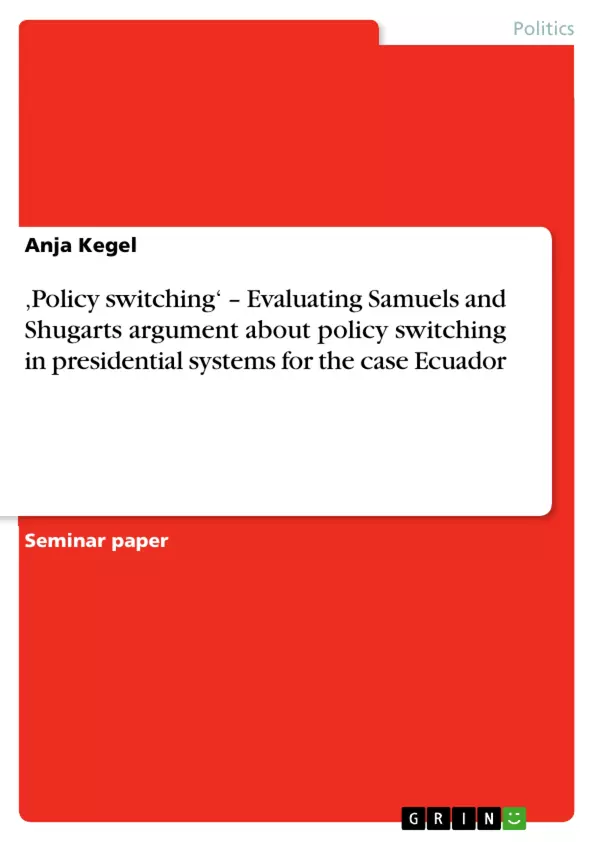Policy-switching are situations which results from shifts in the behavior of executives. More specifically, it means that executives once in office changed their previously campaign promise and make other key policy decisions for which they have not been elected. In this context, Samuels and Shugart (2010) tried to analyze the question, which impact does fusion or separation of powers has on policymaking and representation (cf. Samuels/Shugart 2010: 218). Both authors stated that policy-switches are about four times as common under a pure presidential system than under a parliamentary system (cf. ib.: 221). They came to the conclusion that parties or the leaders of the parties switch under separation of powers, especially in situations with close presidential election and minority government (cf. ib.: 248).
The main goal of this paper is to analyze if Samuels and Shugart are right when they claim that policy-switches are more common under a presidential system because of special conditions which favors the president to change his or her behavior and violate their mandate by betraying their stated campaign commitments. To evaluate their argument, the country Ecuador has been selected, which is a country with a presidential system and there were four policy-switches in the years 1988, 1992, 1996 and 2002. Therefore, the central question of this paper is, whether Ecuador is a case that fits very well in Samuels and Shugarts argument about policy switching or not.
I suspected that situations with close presidential elections and minority legislative were the main causes for the policy-switches in Ecuador. And, secondly, I assumed that all Ecuadorian policy-switches were the only option because the promised measures were impracticable under extremely worst economic conditions. All Ecuadorian policy-switches were compared according to institutional, partisan and economic factors. Finally, I come to the conclusion that Samuels and Shugart are partly right in their argumentation about the impact of separation of powers on policy-switches, because the result of this paper shows that the combination of institutional, partisan and economic factors had an obvious influence on the four presidential policy-switches in Ecuador.
Inhaltsverzeichnis (Table of Contents)
- Introduction
- The relation between presidential systems and policy-switching
- Structure of the course paper
- „Policy-switching“ – the approach from Samuels and Shugart
- Their understanding of the policy-switching' concept
- The impact of separation of powers on policy-switches
- Their empirical approach with regard to presidential systems
- Ecuador's economic development and executive
- Ecuador's political and economic development from 1979 to 2002
- Ecuadorian presidents and their institutional environment
- Evaluating Samuels and Shugarts arguments about policy-switching
- Four policy-switches in Ecuador and their background
- Causes for the Ecuadorian policy-switches
- Fits Ecuador very well in Samuels and Shugarts argumentation or not?
- Conclusion and outlook
Zielsetzung und Themenschwerpunkte (Objectives and Key Themes)
This paper aims to evaluate the argument made by Samuels and Shugart regarding the occurrence of "policy-switching" in presidential systems. The paper examines whether their claim that such switches are more common in presidential systems due to specific conditions favoring presidential behavior change holds true in the case of Ecuador. The key themes explored in this paper include:- The concept of policy-switching and its relationship to presidential systems
- The impact of separation of powers on policy-switching, particularly in situations with close elections and minority governments
- The institutional, partisan, and economic factors influencing policy-switching in Ecuador
- The evaluation of Samuels and Shugarts' argument in the context of Ecuador's political and economic development
Zusammenfassung der Kapitel (Chapter Summaries)
Introduction
This section introduces the concept of policy-switching, which refers to situations where executives in office deviate from their campaign promises and make policy decisions not originally mandated by the electorate. The paper focuses on analyzing the argument by Samuels and Shugart (2010) that policy-switching is more prevalent in presidential systems than in parliamentary systems due to the separation of powers. The research question is whether Ecuador, a country with a presidential system, supports this argument. The paper anticipates that close presidential elections and minority governments, coupled with economic constraints, could contribute to policy-switching in Ecuador.„Policy-switchingʻ – the approach from Samuels and Shugart
This chapter delves into Samuels and Shugarts' concept of policy-switching, highlighting their assertion that separation of powers creates disincentives for consistent mandate representation. They argue that presidential systems are more susceptible to policy-switching due to the separation of origin and survival of the executive and legislature. The chapter also outlines their theoretical framework for analyzing policy-switching, drawing upon concepts such as prospective voting and mandate representation.Ecuador's economic development and executive
This section provides context by outlining Ecuador's political and economic development from 1979 to 2002. It examines the institutional environment within which Ecuadorian presidents operated, including the structure of the executive branch and the political landscape. This information serves as a foundation for understanding the context of the policy-switches that occurred during this period.Evaluating Samuels and Shugarts arguments about policy-switching
This chapter analyzes four policy-switches that occurred in Ecuador during the years 1988, 1992, 1996, and 2002. It explores the underlying causes of these switches, considering factors such as institutional constraints, partisan politics, and economic conditions. The chapter ultimately evaluates whether Ecuador aligns with Samuels and Shugarts' argument regarding the prevalence of policy-switching in presidential systems.Schlüsselwörter (Keywords)
This paper explores the concept of "policy-switching" within presidential systems, focusing on the argument of Samuels and Shugart (2010). Key terms and concepts include: presidential systems, separation of powers, mandate representation, prospective voting, policy-switching, institutional factors, partisan factors, economic factors, Ecuador, and case study. The paper analyzes the impact of these factors on policy-switching in Ecuador, ultimately assessing the validity of Samuels and Shugarts' argument.- Quote paper
- M.A. Politikwissenschaft Anja Kegel (Author), 2012, ‚Policy switching‘ – Evaluating Samuels and Shugarts argument about policy switching in presidential systems for the case Ecuador, Munich, GRIN Verlag, https://www.grin.com/document/204064



